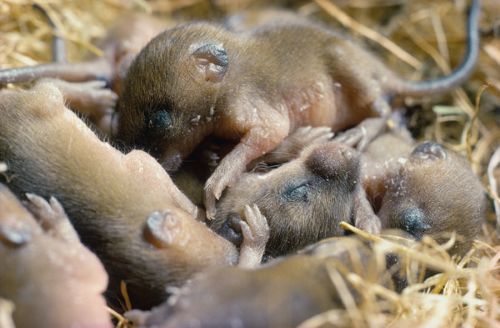May 15, 2025 Research Highlight Biology
How hunger pangs push back the onset of puberty
A neural connection between sensations of hunger and the delayed onset of puberty has been teased out for the first time

Figure 1: Giving birth to young places a large burden on mammalian mothers, and so the onset of puberty is delayed when food is in short supply. A team at RIKEN has discovered the neural connection behind this mechanism. © Oxford Scientific/The Image Bank/Getty
The neural circuit responsible for delaying the onset of puberty in underfed mice has been discovered by neuroscientists at RIKEN1. The same circuit is expected to play a similar role in humans too.
Having offspring places large demands on female mammals, and they need adequate food to be able to bear them. There is a natural mechanism that limits pregnancies during times of food shortages—the onset of puberty is delayed in young, undernourished females. Interestingly, the opposite effect may be at work in women in the developed world today. “Women today tend to experience puberty earlier than previous generations,” notes Kazunari Miyamichi of the RIKEN Center for Biosystems Dynamics Research (BDR). “This is likely influenced by increased consumption of high-fat, processed foods.”
Conversely, malnourishment or anorexia can push back puberty in girls. But the mechanism that determines the timing of the onset of puberty based on food availability has not previously been well understood.
Now, Miyamichi and Teppei Goto, also of BDR, and their co-workers have uncovered the neural pathways in female mice that connect feelings of hunger with the delayed onset of puberty.
They found that, in well-fed mice nearing puberty, neurons in the hypothalamus that produce kisspeptin—a protein that plays a crucial role in regulating reproductive hormones—exhibit pulsatile activity in which hundreds of them fire synchronously and repeatedly. This pulsatile activity became more frequent, the closer a mouse came to puberty.
But in underfed mice, neurons in the arcuate nucleus—a center in the hypothalamus that registers hunger—reduced the frequency of the pulsatile activity, effectively applying the brakes to the onset of puberty.
At first, Miyamichi thought that hormones might act as the go-between between malnutrition and kisspeptin neuron activity. But the response was much too rapid for that.
“A major surprise was the discovery that, once food becomes available, the pulsatile activity of kisspeptin neurons recovers remarkably quickly—within just a few hours,” says Miyamichi.
That finding prompted his team to look into fast-acting neural pathways involved in the sensing of hunger and satiety.
It is highly likely that a similar mechanism operates in people too, Miyamichi believes. “Given the highly conserved nature of the protein-expressing neurons and kisspeptin in the human arcuate nucleus, there’s little reason to doubt that similar mechanisms operate in humans,” he says.
For Miyamichi, this study is just the beginning. “I believe there’s much more to uncover during the juvenile-to-adolescent period—a developmental window that remains relatively underexplored in neuroscience, which has traditionally focused on the adult brain,” he says.

Teppei Goto (left) and Kazunari Miyamichi (right), with their co-workers, have uncovered how the hypothalamic neural circuit in mice delays puberty onset when food is scarce. © 2025 RIKEN
Related contents
- ‘Cuddle hormone’ oxytocin strongly affects male mice on becoming fathers
- Coordination of hormonal signaling and nutrient metabolism drives critical life-cycle transition
- Vulnerable neurons linked to social dysfunction in autistic mice
Rate this article
Reference
- 1. Goto, T., Hagihara, M., Irie, S., Abe, T., Kiyonari, H. & Miyamichi, K. Dietary availability acutely influences puberty onset via a hypothalamic neural circuit. Neuron 113, 1036–1050 (2025). doi: 10.1016/j.neuron.2025.01.015
